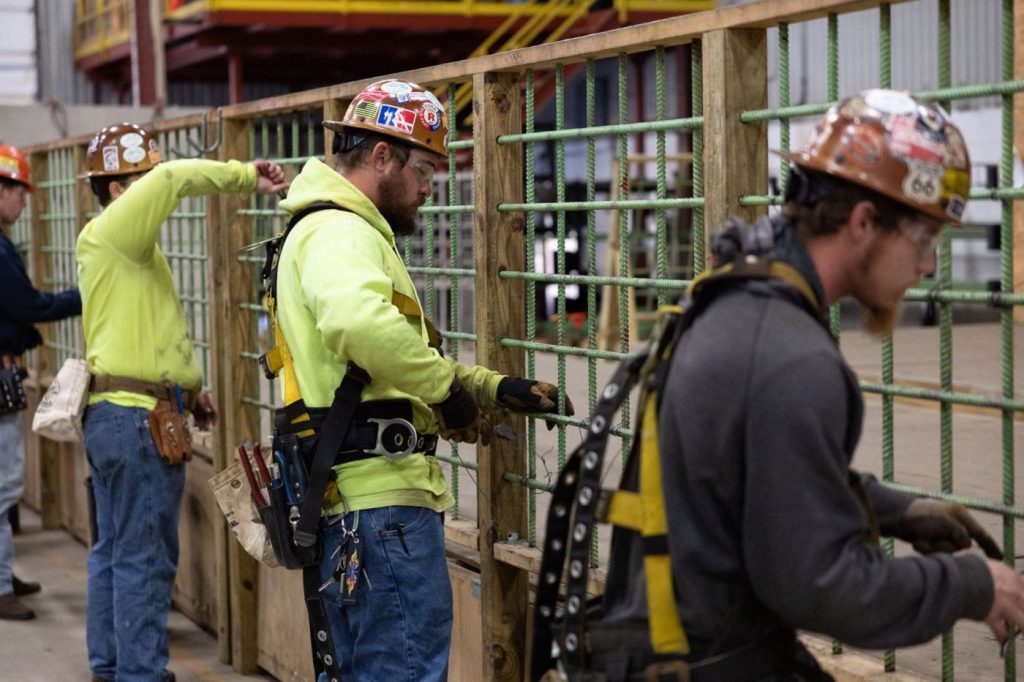Colleen Schrappen | (TNS) St. Louis Post-Dispatch
ST. LOUIS — Both of Dan Tague’s parents earned bachelor’s degrees. So did his older sister and brother.
But as his turn approached, Tague, 20, saw a different route. In high school, he designed sets for plays and enrolled in any “hands-on” classes he could. By the time he graduated, he decided he wanted to be an electrician.
His mom and dad needed no convincing.
“They knew right out of the gate, you have a paycheck,” he said.
After years of decline, the skilled trades are experiencing a renaissance, propelled by young adults like Tague. Soaring college tuition and student debt have upended the long-held belief that higher education is the key to success. And the stigma that many of Generation Z’s parents held about careers in carpentry or mechanics is crumbling.
Enrollment in four-year schools has flatlined, while vocation-focused community colleges experienced 16% growth in the past year, the biggest jump since the National Student Clearinghouse began tracking such data in 2018. Mechanical and repair programs saw 8% enrollment gains in the past year; precision machinery classes grew by 7.5%. Students studying construction ticked up by about 1% last year, but their ranks have increased by almost 14% over the past five years.
In the St. Louis area, employers are partnering with high schools to grab the attention of teenagers early. Community colleges and trade schools are offering new certifications and building new facilities. Young adults are being pulled onto a cheaper, quicker path to the workforce. No debt, no delays.
Tague received his associate of applied science degree in electrical technology in May at Mineral Area College. The school in Park Hills opened an 80,000-square-foot Industry and Technology Center last August to house labs, machinery and classrooms for its 30-plus certificate programs. More than 100 students took skilled trades classes in the semester that just ended, almost twice as many as the year before.
People didn’t always think of MAC as a technical school, said Joe Gilgour, the college’s president.
“But the new building has made a splash,” he said.
Two years ago, the school started a welding curriculum. Construction and HVAC were added last year, and the first class of automotive technicians will be welcomed this fall.
The additions are mostly the result of meetings with industry leaders, Gilgour said. Companies need trained workers, and they are willing to pay for them. Many shorter-term certifications are funded by employers.
Tague’s tuition was covered by Missouri’s A+ Scholarship program, which he completed during high school. This summer, he will begin an earn-and-learn apprenticeship with the International Brotherhood of Electrical Workers. In a couple of years, he should have his journeyman’s license.
After another two years, he will become a master electrician and, he figures, will bring in about $80,000 annually.
Ticket to the middle class
Over a lifetime, college graduates typically earn more and have higher employment rates than those without four-year degrees. But within those broad categories, the discrepancies can shrink — or even disappear— based on the field. According to the U.S. Bureau of Labor Statistics, for example, the median income for plumbers was $61,500 last year — almost $3,000 more than social workers.
And students who graduated in 2023 with bachelor’s degrees carried an average of about $30,000 in debt, according to the College Board.
“Careers in the trades are good-paying,” said Megan Price, the executive director of the Missouri Works Initiative. “They are truly a ticket to the middle class.”
Three years ago, the Missouri AFL-CIO launched the nonprofit initiative to help draw people to the trades.
“We have to make progress about getting young people excited about these careers,” Price said.
This summer, Missouri Works is extending its outreach efforts to high schoolers through a Boys & Girls Clubs partnership called the Skilled Trades Exploration Program, or STEP. Community and technical colleges have also focused on secondary schools, visiting counseling offices and hosting career fairs and “try-it” days.
Sharon Brueggemann, vice president of education at Ranken Technical College, refers to high school teachers and counselors as “influencers.” Once they are on board, the kids will follow. The popularity of robotics teams and coding camps have helped the skilled trades shake off a reputation as “dirty” work done by people who don’t land at a university.
The pandemic shifted mindsets, too. College enrollment fell. White-collar jobs weathered layoffs. Burnout spread through industries such as education and health care.
But the prospects in building and manufacturing boomed.
“Everyone needed tradespeople during COVID,” Brueggemann said.
Ranken, which set up shop in St. Louis in 1907, has seen an increase in competition as specialized vocational schools have proliferated and community colleges have expanded.
But that hasn’t stunted Ranken’s growth. In 2013, its first satellite campus opened with 200 students in Wentzville. Next came Perryville, in 2017; then Troy, Missouri, two years ago, to accommodate spillover from the Wentzville location. Ashland had a soft opening in January, with all programs scheduled to be running this fall. The Troy and Ashland sites provide space for the local high schools to use.
Today, about 3,400 people are enrolled at Ranken in St. Louis, with another 800 at Wentzville and Troy, and 130 in Perryville.
Ranken students have a 98% job placement rate, said Brueggemann. Often, they secure positions before their first year of classes is over.
“By the time they graduate, it’s too late for employers,” she said.
A shortage of workers has plagued many professions, especially plumbing and HVAC, as the number of retirees surpasses trainees. More than a third of tradespeople are older than 50, according to the Bureau of Labor Statistics. But the recent surge in interest has chipped away at the workforce deficit.
Jalen Watson, 20, attended an open house on a recent Saturday for St. Louis Community College’s Center for Workforce Innovation in Ferguson. Watson, of north St. Louis County, wanted to find out about becoming an HVAC technician.
He already works with heating and ventilation systems at his job in maintenance at St. Louis University. But certification — which requires two weeks of classes and costs $1,300 — could boost his pay from $20 an hour to $30.
“A lot of school isn’t for me,” Watson said. “I really like solving problems.”
‘Might as well build it’
As a kid, 18-year-old David Maloney dreamed of being a pilot. But recurring vertigo made that impossible. So during his sophomore year of high school, Maloney, who lives in Maplewood, settled on becoming a welder.
“If I can’t fly it, I might as well build it,” he thought.
By his junior year, he was taking classes at South Technical High School in the mornings and Maplewood Richmond Heights in the afternoons. Last fall, he went on a tour at Boeing and applied for an evening “pre-employment” sheet-metal assembly program for second-semester seniors.
Maloney finished high school and the 200-hour Boeing course on the same weekend last month. He’ll have an interview with the airplane-maker later this summer. In the meantime, he works at Classic Metal Craft, a fabricator in St. Louis.
Boeing also sponsors two adult “pathways” for assembly mechanic jobs through St. Louis Community College.
“We do a lot of recruiting,” said Dan Stroot, a manager at Boeing. “We’re trying to get them in as fast as we can.”
The number of registered trade apprentices in Missouri has swelled by 150% over the past 10 years. But demand is still outpacing supply. And the $1.2 trillion federal infrastructure plan that passed in 2021 is expected to create 1.5 million construction jobs over the next decade, the White House says.
Kevin Rushton’s education at Southwestern Illinois College in Belleville was paid for by Seyer Industries, an aerospace manufacturer in St. Peters. He landed a summer internship there three years ago, after he graduated high school in Staunton.
“I had zero experience going in,” said Rushton, 21.
He quickly found himself ahead. His precision machining classes made more sense because he was practicing the techniques at Seyer.
Rushton graduated from SWIC in May. He is staying on at Seyer, with a pay bump taking him from $23 an hour to almost $30.
SWIC is opening a $20 million Advanced Manufacturing Academy on its Belleville Campus this fall as a hub for its manufacturing curriculum.
Laura Vahlkamp, the associate director of recruitment and outreach, anticipates ongoing interest in skilled trades coursework.
“There is a changing perception of what a career looks like,” Vahlkamp said. “Students are more knowledgeable about what these types of programs are and what kind of jobs they can get.”
©2024 STLtoday.com. Distributed by Tribune Content Agency, LLC.


